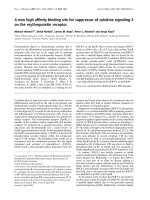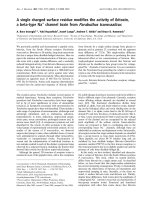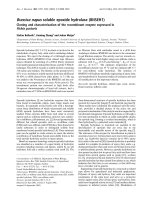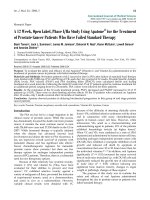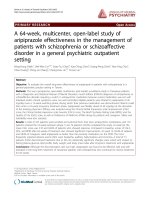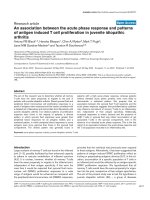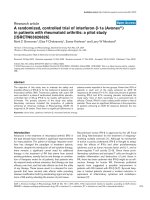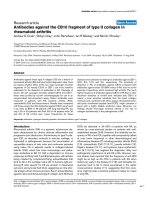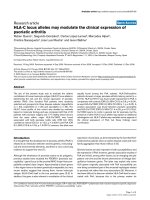Báo cáo y học: "A multicenter, double-blind, randomized, controlled phase III clinical trial of chicken type II collagen in rheumatoid arthritis" ppsx
Bạn đang xem bản rút gọn của tài liệu. Xem và tải ngay bản đầy đủ của tài liệu tại đây (294.44 KB, 10 trang )
Open Access
Available online />Page 1 of 10
(page number not for citation purposes)
Vol 11 No 6
Research article
A multicenter, double-blind, randomized, controlled phase III
clinical trial of chicken type II collagen in rheumatoid arthritis
Wei Wei
1
, Ling-Ling Zhang
1
, Jian-Hua Xu
2
, Feng Xiao
1
, Chun-De Bao
3
, Li-Qing Ni
4
, Xing-Fu Li
5
,
Yu-Qing Wu
6
, Ling-Yun Sun
7
, Rong-Hua Zhang
8
, Bao-Liang Sun
9
, Sheng-Qian Xu
2
, Shang Liu
2
,
Wei Zhang
3
, Jie Shen
4
, Hua-Xiang Liu
5
and Ren-Cheng Wang
9
1
Institute of Clinical Pharmacology, Anhui Medical University, Key Laboratory of Anti-inflammatory and Immunopharmacology of Education Ministry,
81 Meishan Road, Hefei 230032, PR China
2
Rheumatism and Immunity Department, The First Affiliated Hospital of Anhui Medical University, 218 Jixi Road, Hefei 230022, PR China
3
Rheumatism and Immunity Department, The Affiliated Shanghai Renji Hospital of Shanghai Jiao Tong University, 1630 Dongfang Road, Shanghai
200127, PR China
4
Rheumatism and Immunity Department, Shanghai Guanghua Hospital, 540 Xinhua Road, Shanghai 200052, PR China
5
Rheumatism and Immunity Department, Qilu Hospital of Shandong University, 107 Wenhua Road, Jinan 250012, PR China
6
Rheumatism and Immunity Department, The Third Affiliated Hospital of Sun Yat-Sen University, 600 Tianhe Road, Guangzhou 510630, PR China
7
Rheumatism and Immunity Department, The Affiliated Drum Tower Hospital of Nanjing University Medical School, 321 Zhongshan Road, Nanjing
210008, PR China
8
Rheumatism and Immunity Department, Southwest Hospital of Third Military Surgeon University, 30 Shapingba Gaotanyan Street, Chongqing
400038, PR China
9
Rheumatism and Immunity Department, The Affiliated Hospital of Taishan Medical College, 706 Tanshan Street, Taian 271000, PR China
Corresponding author: Wei Wei,
Received: 10 Jul 2009 Revisions requested: 18 Aug 2009 Revisions received: 29 Sep 2009 Accepted: 1 Dec 2009 Published: 1 Dec 2009
Arthritis Research & Therapy 2009, 11:R180 (doi:10.1186/ar2870)
This article is online at: />© 2009 Wei et al.; licensee BioMed Central Ltd.
This is an open access article distributed under the terms of the Creative Commons Attribution License ( />),
which permits unrestricted use, distribution, and reproduction in any medium, provided the original work is properly cited.
Abstract
Introduction Chicken type II collagen (CCII) is a protein
extracted from the cartilage of chicken breast and exhibits
intriguing possibilities for the treatment of autoimmune diseases
by inducing oral tolerance. A 24-week, double-blind, double-
dummy, randomized, methotrexate (MTX)-controlled study was
conducted to evaluate the efficacy and safety of CCII in the
treatment of rheumatoid arthritis (RA).
Methods Five hundred three RA patients were included in the
study. Patients received either 0.1 mg daily of CCII (n = 326) or
10 mg once a week of MTX (n = 177) for 24 weeks. Each
patient was evaluated for pain, morning stiffness, tender joint
count, swollen joint count, health assessment questionnaire
(HAQ), assessments by investigator and patient, erythrocyte
sedimentation rate (ESR), and C-reactive protein (CRP) by
using the standard tools at baseline (week 0) and at weeks 12
and 24. Additionally, rheumatoid factor (RF) was evaluated at
weeks 0 and 24. Measurement of a battery of biochemical
parameters in serum, hematological parameters, and urine
analysis was performed to evaluate the safety of CCII.
Results Four hundred fifty-four patients (94.43%) completed
the 24-week follow-up. In both groups, there were decreases in
pain, morning stiffness, tender joint count, swollen joint count,
HAQ, and assessments by investigator and patient, and all
differences were statistically significant. In the MTX group, ESR
and CRP decreased. RF did not change in either group. At 24
weeks, 41.55% of patients in the CCII group and 57.86% in the
MTX group met the American College of Rheumatology 20%
improvement criteria (ACR-20) and 16.89% and 30.82%,
respectively, met the ACR 50% improvement criteria (ACR-50).
Both response rates for ACR-20 and ACR-50 in the CCII group
were lower than those of the MTX group, and this difference was
statistically significant (P < 0.05). The DAS28 (disease activity
score using 28 joint counts) values of the two treatment groups
were calculated, and there was a statistically significant
difference between the two treatment groups (P < 0.05).
Gastrointestinal complaints were common in both groups, but
there were fewer and milder side effects in the CCII group than
in the MTX group. The incidence of adverse events between the
two groups was statistically significant (P < 0.05).
ACR: American College of Rheumatology; ACR-20: American College of Rheumatology 20% improvement criteria; ACR-50: American College of
Rheumatology 50% improvement criteria; CCII: chicken type II collagen; CIA: collagen-induced arthritis; CII: type II collagen; CRP: C-reactive protein;
DAS28: disease activity score using 28 joint counts; ESR: erythrocyte sedimentation rate; HAQ: health assessment questionnaire; IL: interleukin; ITT:
intention-to-treat; MTX: methotrexate; NSAID: non-steroidal anti-inflammatory drug; RA: rheumatoid arthritis; RF: rheumatoid factor; TGF-β: transform-
ing growth factor-beta; Treg: regulatory T; VAS: visual analogue scale.
Arthritis Research & Therapy Vol 11 No 6 Wei et al.
Page 2 of 10
(page number not for citation purposes)
Conclusions CCII is effective in the treatment of RA and is safe
for human consumption. CCII exerts its beneficial effects by
controlling inflammatory responses through inducing oral
tolerance in RA patients.
Trials Registration Clinical trial registration number: ChiCTR-
TRC-00000093.
Introduction
Rheumatoid arthritis (RA) is a chronic inflammatory disease
characterized by pain, swelling, and stiffness of multiple joints.
It is also a highly disabling disease that limits mobility, hampers
work, and reduces quality of life. Chronic inflammation com-
monly results in progressive joint destruction, deformity, and
loss of function. Complex immune mechanisms contribute to
the pathology of RA [1,2]. Current pharmacological strategies
addressing mainly immune suppression and anti-inflammatory
mechanisms have had limited success. Currently, most drugs
for RA are steroids, non-steroidal anti-inflammatory drugs
(NSAIDs), disease-modifying drugs, and biological agents.
These therapies are associated with significant side effects
with long administration, including anorexia, dyspepsy, sup-
pression of the immune system non-specifically, and infections
[3-5].
Recently, more and more oral tolerance mechanisms have
been studied in the treatment of autoimmune diseases. Oral
tolerance has posed intriguing possibilities for the treatment of
autoimmune diseases, including RA. Oral tolerance is a state
of systemic immune suppression to an antigen induced by oral
feeding of the same antigen. Extensive research in this area
over the past 10 years has led to the conclusion that two
mechanisms are operative in the mediation of oral tolerance:
active suppression and clonal anergy or deletion. A number of
factors that determine which mechanisms of tolerance are
operative have been identified: antigen dose, antigen form,
and the timing of antigen administration [6,7].
Oral administration of autoantigen has been shown to sup-
press a variety of autoimmune pathologies induced experimen-
tally, including antigen-induced RA [8]. Modulating the
immune response to the autoantigen by oral tolerance may be
a safer and more effective treatment. A number of candidate
autoantigens have been identified in RA [9]. Type II collagen
(CII) is a major protein in articular cartilage and a potential
autoantigen. Some RA patients demonstrate immunity against
CII, and autoantibodies to CII have been detected in the sera
of both pauciarticular-onset and systemic-onset RA patients
[10]. These data support the view that autoimmunity to an anti-
gen such as CII in cartilage plays a major role in the pathogen-
esis of RA. In animal models, oral administration of CII prevents
and reduces the severity of autoimmune diseases [11]. Work
from these animal models has recently been extended into
human clinical trials of RA with differing degrees of success
[12-14]. Hence, oral tolerance has been advocated as a treat-
ment strategy for autoimmune diseases, including RA.
Investigators in our laboratory found that collagen-induced
arthritis (CIA) could be established in Wistar rats, Kunming
mice, and DBA/1 mice with chicken type II collagen (CCII)
[15,16]. Feeding CCII to rats by oral administration decreased
the arthritis index. Meanwhile, cartilage degeneration, syn-
ovium hyperplasia, and inflammatory cell infiltration in the knee
joints of mice and rats with CIA were suppressed by CCII
[17,18]. These experiments in rodents have provided the basis
for human clinical trials. In a randomized, double-blind, multi-
center, and controlled phase II clinical trial involving 236
patients with severe active RA, a decrease in the number of
swollen joints and tender joints occurred in subjects fed CCII
for 6 months. Meanwhile, CCII could reduce pain, morning
stiffness, health assessment questionnaire (HAQ), and
assessments by investigator and patient, and the incidence of
adverse events of CCII was lower than that of methotrexate
(MTX) [19]. These results demonstrate clinical efficacy of an
oral tolerance approach for RA. To evaluate the efficacy and
safety of CCII in RA patients further, we treated two groups of
RA patients with oral CCII or MTX in a randomized, double-
blind, multicenter, and controlled phase III clinical trial.
Materials and methods
Recruitment of patients
This trial was performed at eight centers from October 2004
to December 2005 (clinical trial registration number: ChiCTR-
TRC-00000093). The study protocol was evaluated and
approved by their respective investigational and ethics com-
mittees. Five hundred three intention-to-treat (ITT) population
RA patients (18 to 65 years old) who met revised American
College of Rheumatology (ACR) criteria for the diagnosis of
RA were entered into the study after giving their written
informed consent [20]. There are no patients in the phase II
study who were enrolled in this phase III trial. Table 1 defines
the study population. Admission criteria also included patients
of either gender with RA with a duration of 6 to 24 months.
Active RA was defined as the presence of at least three of the
following criteria: six or more painful or tender joints, three or
more swollen joints, morning stiffness for at least 45 minutes
(on average during the week prior to entry), and an erythrocyte
sedimentation rate (ESR) of at least 28 mm. Second-line
agents were discontinued at least 4 weeks prior to entry. Con-
tinuous doses of NSAIDs were permitted. Patients to whom
one of following applied were excluded: dysfunction of liver;
severe cardiovascular, urinary, hematopoietic, or endocrine
system disease; immunodeficiency; uncontrolled infection or
active gastrointestinal tract disease; recent vaccination; grav-
ida; women in lactation period or those recently intending to
Available online />Page 3 of 10
(page number not for citation purposes)
become pregnant; hypersensitivity to CII; treatment with any
other disease-modifying anti-rheumatic drug within 30 days
before enrolment; history of alcohol abuse; history of hyperg-
lycemia or motor coordination disorder; or participation in
other clinical trials within 3 months before enrolment.
Study design
The study was a two-to-one, eight-center, 24-week follow-up,
double-blind, double-dummy, randomized, and MTX-control-
led trial comparing efficacy and safety of CCII and MTX in the
treatment of RA. Patients were randomly assigned to a CCII (n
= 326) or MTX (n = 177) group that received either CCII (0.1
mg daily) or MTX (10 mg once a week). Patients and investi-
gators were blinded to the treatment regimens throughout the
study. Efficacy variables were assessed at 0, 12, and 24
weeks after administration of drug. Patients were allowed to
remain on diclofenac sodium (50 mg daily), an NSAID. The
diclofenac sodium dosage was not changed during the study.
CCII capsules (#040328; Shanghai Materia Medica Bioengi-
neering Institute, Shanghai, China), CCII dummy capsules,
MTX tablets (#031201; Shanghai Xin Yi Pharmaceutical Fac-
tory, Shanghai, China), and MTX dummy tablets were obtained
from Shanghai Materia Medica Bioengineering Institute.
Patients were instructed to take oral CCII capsules or dummy
capsules with 200 mL of cold water 30 minutes prior to eating
breakfast every morning.
Flow sheet of production of chicken type II collagen
CCII is a protein extracted from the cartilage of chicken breast.
Its molecular weight is 115 to approximately 135 kDa by SDS-
PAGE electrophoresis method. In this study, the CCII capsule
that patients received consisted of CCII and an adjuvant such
as mannitol and glidantin. Figure 1 shows the flow sheet of
production of CCII.
Clinical assessments
Clinical assessments of efficacy were made at baseline and
repeated 12 and 24 weeks later. Efficacy variables included
[21,22] pain, and pain intensity was assessed by visual ana-
logue scale (VAS) of 0 (no pain) to 10 (severe pain). Patients
were questioned about the duration of morning stiffness expe-
rienced on the day before each study visit. Joint counts for ten-
derness and swelling were the sum of the number of affected
joints. Physician and patient global assessments were rated
according to VAS of 0 (very good) to 10 (very poor). Func-
tional status was assessed at baseline and at 12 and 24
weeks using HAQ. ESR and C-reactive protein (CRP) values
were obtained at baseline and at 12 and 24 weeks. Rheuma-
toid factor (RF) positivity was determined at the screening visit
and at 24 weeks.
The primary efficacy variable was the ACR preliminary defini-
tion of improvement in RA [23]. To reach improvement accord-
ing to the ACR definition, a patient with RA must improve by at
least 20% in tender and swollen joint count and by at least
20% in three of the five other measures: patient global assess-
Table 1
Comparison of baseline clinical characteristics between the chicken type II collagen group and the methotrexate group
Variables CCII (n = 296) MTX (n = 158) P value
Gender, male/female 55/241 30/128 0.983
Age, years 47.11 ± 10.55 47.06 ± 11.14 0.967
Duration of rheumatoid arthritis, years 1.63 ± 0.75 1.72 ± 0.52 0.949
Body temperature, °C 36.66 ± 0.38 36.65 ± 0.39 0.892
Pain (VAS
a
) 6.02 ± 1.43 5.91 ± 1.76 0.528
Morning stiffness, minutes 99.26 ± 25.14 104.89 ± 26.42 0.277
Tender joint count 13.34 ± 6.43 14.09 ± 6.82 0.233
Swollen joint count 10.38 ± 6.63 10.57 ± 7.25 0.773
HAQ
b
0.82 ± 0.56 0.86 ± 0.55 0.454
Physician's assessment (VAS) 5.83 ± 1.54 5.78 ± 1.26 0.892
Patient's assessment (VAS) 6.01 ± 1.51 6.06 ± 1.71 0.731
ESR
c
, mm/hour 38.18 ± 27.58 42.51 ± 29.37 0.118
C-reactive protein, mg/L 17.52 ± 8.27 23.24 ± 9.81 0.306
Rheumatoid factor, U/mL 203.65 ± 61.95 198.99 ± 21.31 0.115
The same variables were compared between the chicken type II collagen (CCII) group and the methotrexate (MTX) group. Fisher exact test was
used for categorical variables, and t analysis of variance was used for continuous variables.
c
ESR, erythrocyte sedimentation rate;
b
HAQ, health
assessment questionnaire; MTX, methotrexate;
a
VAS, visual analogue scale.
Arthritis Research & Therapy Vol 11 No 6 Wei et al.
Page 4 of 10
(page number not for citation purposes)
ment, physician global assessment, HAQ, acute-phase reac-
tant, and patient pain assessment. In addition to the evaluation
of 20% improvement (ACR-20), we determined RA improve-
ment based on more substantial changes in RA core set meas-
ures, such as requiring at least 50% improvement (ACR-50)
reported as secondary efficacy measures. The disease activity
score using 28 joint counts (DAS28) was evaluated [24]. Clin-
ical parameters also included body weight, blood pressure,
and heart rate. To standardize the evaluation of clinical varia-
bles, all investigators prior to study entry performed clinical
evaluation of one patient with active RA.
Adverse events
At each visit, the patient was asked whether side effects were
noticed during the interim. Side effects such as gastrointesti-
nal complaints, vomiting, anorexia, headache, dizziness,
insomnia, tetter, and mouth ulcers were known to occur fre-
quently in treatment with CCII or MTX. Moreover, at entry and
at 12 and 24 weeks, the following laboratory variables were
assessed to monitor safety: complete blood cell count, serum
levels of liver enzymes, creatinine, uric acid, and urinalysis.
Statistical analysis
Safety assessments were performed on all patients who con-
sumed any masked study medication. Efficacy analyses were
performed on the ITT population as well as on the population
of patients who completed the 24-week study. Efficacy analy-
sis of outcome variables was based on mean changes from
baseline to endpoint in the ITT population. The data in Tables
1 and 2 and Figure 2 are expressed as mean ± standard devi-
ation. The statistical software product used for these analyses
was SAS, version 8.1 (SAS Institute Inc., Cary, NC, USA). All
laboratory variables were subjected to descriptive statistics
and compared by means of the Wilcoxon signed rank test. The
randomization code was exposed only after the database was
locked. Chi-square with Fisher exact test was used for cate-
gorical variables, and t analysis of variance was used for con-
tinuous variables. Significance level was established at 0.05.
Results
Baseline characteristics
Of 503 randomly assigned patients (326 in the CCII group
and 177 in the MTX group), 49 patients withdrew early. Thirty
(9.20%) patients withdrew in the CCII group, and 19
(10.73%) patients withdrew in the MTX group. There were var-
ious reasons for early withdrawal, such as adverse events,
non-compliance, lack of response, and loss at follow-up. Three
patients (0.92%) in the CCII group reported side effects, and
five patients (2.82%) in the MTX group reported side effects.
In the CCII group, three patients (0.92%) withdrew due to lack
of compliance, and four patients (2.25%) withdrew because of
non-compliance in the MTX group. Twelve (3.68%) and four
(2.25%) patients in the CCII group and in the MTX group,
respectively, withdrew because of lack of efficacy. Twelve and
six patients in the CCII group and in the MTX group, respec-
tively, were lost to follow-up. Four hundred fifty-four patients
(296 in the CCII group and 158 in the MTX group) completed
24 weeks of therapy. There were no statistically significant dif-
ferences between the two groups in terms of adverse events,
non-compliance, lack of response, and loss at follow-up. At
study entry, the two groups were well balanced with regard to
demographic characteristics and disease parameters, and
there were no statistically significant differences between the
two groups in terms of gender, age, disease duration, body
temperature, pain, morning stiffness, tender joint count, swol-
len joint count, HAQ, physician's assessment, patient's
assessment, ESR, CRP, and RF (Table 1). Also, there were no
important differences among the eight centers.
Efficacy
In both groups, there were decreases in pain, morning stiff-
ness, tender joint count, swollen joint count, HAQ, and
assessments of efficacy by both investigator and patient.
Within-group differences (study entry versus 12 and 24
weeks) were statistically significant for the above clinical dis-
ease parameters (Table 2). At 12 weeks, there were statisti-
cally significant differences in morning stiffness, swollen joint
count, HAQ, physician's assessment, and patient's assess-
ment between the CCII group and the MTX group; there were
statistically significant differences in pain, HAQ, and patient's
Figure 1
The flow sheet of production of chicken type II collagen (CCII)The flow sheet of production of chicken type II collagen (CCII). CCII is
a protein extracted from the cartilage of chicken breast. Its molecular
weight is 115 to approximately 135 kDa by SDS-PAGE electrophore-
sis method. In this study, the CCII capsule that patients received con-
sisted of CCII and an adjuvant such as mannitol and glidantin.
Available online />Page 5 of 10
(page number not for citation purposes)
Table 2
Results in outcome variables at entry and at 12 and 24 weeks
Outcome variables CCII P value
a
MTX P value
a
P value
b
Pain (VAS)
Entry 6.02 ± 1.43 5.91 ± 1.76 >0.05
12 weeks 4.59 ± 2.22 <0.01 4.09 ± 1.99 <0.01 >0.05
24 weeks 3.58 ± 2.55 <0.01 3.38 ± 2.35 <0.01 <0.05
Morning stiffness, minutes
Entry 99.26 ± 25.14 104.89 ± 26.42 >0.05
12 weeks 62.66 ± 25.06 <0.01 45.83 ± 21.28 <0.01 <0.01
24 weeks 36.12 ± 17.21 <0.01 33.98 ± 12.59 <0.01 >0.05
Tender joint count
Entry 13.34 ± 6.43 14.09 ± 6.82 >0.05
12 weeks 9.14 ± 6.67 <0.01 8.78 ± 6.01 <0.01 >0.05
24 weeks 6.34 ± 4.81 <0.01 7.22 ± 6.91 <0.01 >0.05
Swollen joint count
Entry 10.38 ± 6.63 10.57 ± 7.25 >0.05
12 weeks 6.89 ± 5.46 <0.01 5.63 ± 4.97 <0.01 <0.01
24 weeks 4.26 ± 2.03 <0.01 4.38 ± 2.94 <0.01 >0.05
HAQ
Entry 0.82 ± 0.56 0.86 ± 0.55 >0.05
12 weeks 0.65 ± 0.41 <0.01 0.51 ± 0.42 <0.01 <0.01
24 weeks 0.43 ± 0.27 <0.01 0.44 ± 0.21 <0.01 <0.05
Physician's assessment (VAS)
Entry 5.83 ± 1.54 5.78 ± 1.26 >0.05
12 weeks 4.68 ± 2.09 <0.01 4.03 ± 2.06 <0.01 <0.01
24 weeks 3.81 ± 1.52 <0.01 3.53 ± 1.64 <0.01 >0.05
Patient's assessment (VAS)
Entry 6.01 ± 1.51 6.06 ± 1.71 >0.05
12 weeks 4.86 ± 2.01 <0.01 4.31 ± 2.06 <0.01 <0.01
24 weeks 3.92 ± 2.45 <0.01 3.71 ± 2.04 <0.01 <0.05
ESR
c
, mm/hour
Entry 38.18 ± 17.58 42.51 ± 19.37 >0.05
12 weeks 38.03 ± 14.17 >0.05 35.84 ± 13.24 <0.01 <0.01
24 weeks 37.53 ± 10.22 >0.05 34.21 ± 15.25 <0.01 <0.01
C-reactive protein, mg/L
Entry 17.52 ± 8.27 23.24 ± 9.81 >0.05
12 weeks 17.27 ± 15.14 >0.05 16.01 ± 13.41 <0.01 <0.05
24 weeks 15.56 ± 12.38 >0.05 15.08 ± 12.25 <0.01 <0.05
Rheumatoid factor, U/mL
Entry 203.65 ± 61.95 198.99 ± 21.31 >0.05
24 weeks 150.21 ± 16.18 >0.05 123.35 ± 11.32 >0.05 >0.05
In both groups, there were decreases in pain, morning stiffness, tender joint count, swollen joint count, health assessment questionnaire (HAQ),
and global assessment of efficacy by investigator and patient. Within-group differences (study entry versus 12 and 24 weeks) were statistically
significant. In the methotrexate (MTX) group, erythrocyte sedimentation rate (ESR) and C-reactive protein decreased, but changes in the two
variables in the chicken type II collagen (CCII) group were not significant. Rheumatoid factor was not significantly affected by either drug therapy.
VAS, visual analogue scale. P value
a
, entry versus 12 or 24 weeks in CCII group or MTX group; P value
b
, CCII group versus MTX group;
c
ESR,
erythrocyte sedimentation rate.
Arthritis Research & Therapy Vol 11 No 6 Wei et al.
Page 6 of 10
(page number not for citation purposes)
assessment at 24 weeks between the two groups. In the MTX
group, ESR and CRP decreased at 12 and 24 weeks, but
changes in the two variables in the CCII group were not signif-
icant, and there was a statistically significant difference
between the two groups. RF was not significantly affected by
either drug therapy (Table 2).
American College of Rheumatology response criteria
Response rates for ACR-20 and ACR-50 were assessed at
12 and 24 weeks. With an ITT analysis (Figure 2), response
rates for ACR-20 were 30.51% in the CCII group and 44.94%
in the MTX group at 12 weeks. Response rates for ACR-50
were 8.81% and 15.03%, respectively. Response rates for
ACR-20 were 41.55% in the CCII group and 57.86% in the
MTX group at 24 weeks. Response rates for ACR-50 were
16.89% and 30.82%, respectively. Both response rates for
ACR-20 and ACR-50 of the CCII group were lower than those
of the MTX group. These changes were different to a statisti-
cally significant degree between the two treatment groups (P
< 0.05).
Disease activity score using 28 joint counts
The DAS28 values of the two treatment groups were calcu-
lated (Table 3), and the results showed that the numbers of
relief patients (≤ 2.6), low-activity patients (2.6 to approxi-
mately 3.2), mid-activity patients (3.2 to approximately 5.1),
and high-activity patients (>5.1) were 36, 26, 138, and 96,
respectively, in the CCII group at 24 weeks. In the MTX group,
the numbers of relief patients, low-activity patients, mid-activity
patients, and high-activity patients were 20, 19, 88, and 31,
respectively. There was a statistically significant difference
between the two treatment groups (P < 0.05).
Figure 2
Comparison of the effect of American College of Rheumatology 20% improvement criteria (ACR-20) and ACR 50% improvement criteria (ACR-50) between two groups at 12 and 24 weeksComparison of the effect of American College of Rheumatology 20% improvement criteria (ACR-20) and ACR 50% improvement criteria (ACR-50)
between two groups at 12 and 24 weeks. Response rates for ACR-20 and ACR-50 were assessed at 12 and 24 weeks. With an intention-to-treat
analysis, response rates for ACR-20 were 30.51% in the chicken type II collagen (CCII) group and 44.94% in the methotrexate (MTX) group at 12
weeks. Response rates for ACR-50 were 8.81% and 15.03%, respectively. Response rates for ACR-20 were 41.55% in the CCII group and
57.86% in the MTX group at 24 weeks. Response rates for ACR-50 were 16.89% and 30.82%, respectively. Both response rates for ACR-20 and
ACR-50 of the CCII group were lower than those of the MTX group. These changes were different to a statistically significant degree between the
two treatment groups. *P < 0.05 versus CCII group.
Table 3
Comparison of DAS28 between the chicken type II collagen group and the methotrexate group
Group Relief
(≤ 2.6)
Low activity
(2.6~3.2)
Mid activity
(3.2~5.1)
High activity
(>5.1)
Chi-square P value
a
CCII (n = 296) 36 26 138 96 5.476 0.019
MTX (n = 158) 20 19 88 31
a
Showed rank sum test. CCII, chicken type II collagen; DAS28, disease activity score using 28 joint counts; MTX, methotrexate.
Available online />Page 7 of 10
(page number not for citation purposes)
Adverse events
All trials reported data about drug-related adverse outcomes
in the ITT population. The majority of adverse outcomes were
mild to moderate disturbances of the gastrointestinal tract.
Gastrointestinal complaints were the most common adverse
events. Other adverse events included vomiting, anorexia,
headache, dizziness, insomnia, tetter, and mouth ulcers. These
adverse events were mild and did not interfere with the contin-
uation of treatment drugs (Table 4).
The analysis of adverse events was carried out on all 503 ran-
domly assigned patients, and the adverse events of all patients
were generally well tolerated. Adverse events were common in
both groups. During the treatment period, the CCII group
reported 18 (5.52%) adverse events whereas the MTX group
reported 15 (8.47%) at 12 weeks. There were 18 (5.52%)
adverse events in the CCII group and 17 (9.60%) adverse
events in the MTX group at 24 weeks. There were fewer and
milder side effects in the CCII group than in the MTX group
(Table 5). The incidence of adverse events between the CCII
group and MTX group was statistically significant (P < 0.05).
Laboratory variables
In the MTX group, there was a significant increase from base-
line in transaminase and a decrease in white blood cell count.
There were decreases in hemoglobin, platelet count, and neu-
trophil count in both groups, but the differences were insignif-
icant (Table 4). Other laboratory variables were not
significantly affected in the two groups.
Discussion
Oral tolerance has been applied to prevent and treat autoim-
mune disease in several animal models, including arthritis. CII
is the most abundant structural protein of human cartilage. The
cartilage within the joint caused mainly damage of autoimmu-
nity in patients with RA. CII autoimmunity may be a secondary
phenomenon induced following inflammation in the joints and
may play a role in the persistence of the disease rather than in
actual induction of arthritis [25,26]. In either case, downregu-
lation of the immune response to CII may help prevent the
resulting destructive arthritis. Oral administration of CII is an
established procedure for inducing peripheral immune toler-
ance, which suppresses autoimmune responses in RA [27-
29]. Bovine or chicken CII has been administered orally to RA
patients, resulting in some clinical improvement. However, the
precise mechanisms of oral tolerance are not fully known. Ani-
mal studies have revealed that the mechanisms of induction of
oral tolerance include clonal deletion, suppression of the pro-
inflammatory Th1 cells, and the induction of regulatory T (Treg)
cells. Treg cells from Peyer's patches in the gut-associated
lymphoid tissue and transforming growth factor-beta (TGF-β)
are reported to mediate the induction of active suppression
[8,30]. Pro-inflammatory cytokines such as interleukin (IL)-1
and tumor necrosis factor-alpha downregulate and suppres-
sive cytokines such as TGF-β and IL-4 upregulate in oral toler-
ance. Treg cells, defined as a persistently CD25-expressing
subset of CD4
+
cells, may produce anti-inflammatory
cytokines such as IL-10 and TGF-β and are likely to be agents
of bystander suppression [31]. In a basic study, investigators
in our laboratory found that CCII plays an important role in reg-
ulating the immune balance of Th1/Th2 and Th17/Treg in rats
with CIA. CCII decreases the overproduction of pro-inflamma-
tory mediator (IL-2, IL-17) and increases the hypoproduction
of anti-inflammatory mediator (IL-4, TGF-β). These results may
support a mechanism of oral tolerance [32].
A key feature that may affect the induction of Treg cells and
other suppressive mechanisms is the dose of antigen adminis-
tered. A low dose of antigen stimulates the development of
Treg cells, leading to an active immune suppression. The
active mechanism appears to be a cytokine-mediated immune
deviation with a predominant Th2 and Th3 response (TGF-β).
In contrast, high-dose oral antigens lead to clonal deletion and
anergy [33,34]. The active suppression of low-dose oral toler-
ance can also suppress an unrelated immune response
(bystander suppression), paving the way for therapy of autoim-
mune diseases [35]. The results from human clinical trials sug-
gest that a daily dose of significantly less than 1 mg is optimal.
Similarly, data from CIA studies reveal an optimal dose above
and below which there is little or no immune suppression.
Indeed, the incorrect dose can prime the immune response
and aggravate disease. The timing and frequency of adminis-
tration are also vital to the level of immune tolerance induced
and the control of the pathological process [36].
Table 4
Comparison of adverse events between the chicken type II collagen group and the methotrexate group at 12 and 24 weeks
Weeks Groups Adverse events Rate of adverse events Chi-square P value
a
12 CCII (n = 326) 18 5.52% 1.974 0.048
MTX (n = 177) 15 8.47%
24 CCII (n = 326) 18 5.52% 2.001 0.036
MTX (n = 177) 17 9.60%
a
Showed chi-square test. CCII, chicken type II collagen; MTX, methotrexate.
Arthritis Research & Therapy Vol 11 No 6 Wei et al.
Page 8 of 10
(page number not for citation purposes)
In a multicenter study, Barnett and colleagues [14] treated 90
RA patients with CCII for 12 weeks. Patients taking the lowest
dose of CII (20 μg) had a 'significant' improvement in
response rate compared with placebo-treated control patients
(P < 0.035). Corrigall and Panayi [37] also reported a signifi-
cant improvement in a group of RA patients treated with
lyophilized CII. None of the patients in either study had signifi-
cant side effects attributable to treatment with collagen. Simi-
larly, Barnett and colleagues [13] previously reported that 8 of
10 juvenile RA patients had decreased numbers of swollen
and tender joints after 3 months of treatment with CCII. Sieper
and colleagues [38] administered bovine CII orally to patients
with early RA for 12 weeks using doses of either 1 mg/day or
10 mg/day. More patients in the CII-treated groups met the
ACR-20 and ACR-50 improvement criteria than did patients in
the placebo group [23].
On the basis of the above, CCII was developed as a novel
drug of immunologic tolerance. The present study was under-
taken to further evaluate whether oral administration of CCII is
safe and effective in patients with RA. In this phase III trial, CCII
at 0.1 mg daily and MTX at 10 mg once weekly effectively alle-
viated signs and symptoms of active RA. However, the efficacy
of CCII did not exceed that of MTX. The incidence of treat-
ment-related adverse events was significantly different
between the CCII group and the MTX group. According to the
former study, CCII led to few adverse events in patients with
RA [27]. In this study, treatment was carried out in combina-
tion with diclofenac sodium, an NSAID, which can frequently
cause gastrointestinal complaints. The use of diclofenac
sodium can relieve pain. Nevertheless, its mechanism of action
and toxicity can overlap with those of the trial drugs. The effi-
cacy of CCII will be affected since diclofenac sodium can
damage the alimentary system [39].
Above all, treatment of autoimmune diseases by induction of
oral tolerance is attractive because of the few side effects and
easy clinical implementation of this approach. The MTX-con-
trolled, multicenter, 24-week trial in RA patients confirms that
treatment with oral CII leads to improvement in arthritis and no
significant side effects. These results are encouraging and
imply that RA can be effectively treated with oral CII and partly
supported the mechanism of oral tolerance. These data will
provide a basis for more effective application of oral tolerance
induction in RA patients. However, to clarify further the poten-
tial role and effectiveness of CCII as a toleragen in RA, ongo-
ing studies and future work should clarify the autoimmune
response to collagen in the pathogenesis of RA, and long-term
observations in large numbers of patients need to confirm the
efficacy of CCII and determine the optimal doses of orally
administered CCII and which patients with autoimmune dis-
eases will profit most from it.
Conclusions
In summary, the present study provides evidence in support of
the potential efficacy and safety of CCII in patients with RA.
CCII significantly improved joint function and exhibited better
therapeutic efficacy and is safe for human consumption, even
in the long term. This study provides important information
about the efficacy and safety of CCII in the treatment of RA,
and this information may be useful in promoting CCII as a
promising alternative therapeutic strategy that may be used as
a nutritional supplement against RA.
Table 5
Incidence of adverse events
Adverse events CCII (n = 326) MTX (n = 177)
Nausea, vomiting 613
Abdominal pain, epigastric discomfort 17 11
Diarrhea 02
Liver dysfunction 610
Headache, dizziness 3 5
Itching, rash 51
Blood in urine 23
Constipation 10
Edema 21
Alopecia 01
Decrease in white blood cell count 1 5
Decrease in platelet count 0 1
Sum of events 43 53
CCII, chicken type II collagen; MTX, methotrexate.
Available online />Page 9 of 10
(page number not for citation purposes)
Competing interests
The authors declare that they have no competing interests.
Authors' contributions
WW contributed to the design of the project, served as the
study coordinator, and helped to review the manuscript. LLZ
contributed to the design of the project and was primarily
responsible for writing the manuscript. JHX, CDB, LQN, XFL,
YQW, LYS, RHZ, and BLS contributed to patient recruitment
and management and to data collection. SQX, SL, WZ, JS,
HXL, and RCW worked with patients to obtain informed con-
sent, conducted clinical evaluations, took samples, and evalu-
ated the therapeutic response to CCII. FX contributed to
clinical data analysis. All authors read and approved the final
manuscript.
Acknowledgements
Gui-Jun Fei participated in the collection of data. This study was funded
by Shanghai Materia Medica Bioengineering Institute and Shanghai
Baolong Pharmacy Limited Company (Shanghai, China).
References
1. Turner DE, Helliwell PS, Woodburn J: Methodological consider-
ations for a randomised controlled trial of podiatry care in
rheumatoid arthritis: lessons from an exploratory trial. BMC
Musculoskelet Disord 2007, 8:109-119.
2. Chung KC, Burns PB, Wilgis EF, Burke FD, Regan M, Kim HM, Fox
DA: A multicenter clinical trial in rheumatoid arthritis compar-
ing silicone metacarpophalangeal joint arthroplasty with med-
ical treatment. J Hand Surg Am 2009, 34:815-823.
3. Grijalva CG, Chung CP, Arbogast PG, Stein CM, Mitchel EF Jr,
Griffin MR: Assessment of adherence to and persistence on
disease-modifying antirheumatic drugs (DMARDs) in patients
with rheumatoid arthritis. Med Care 2007, 45:S66-76.
4. Boyer JF, Cantagrel A, Constantin A: Impact of traditional thera-
pies and biologics on cardiovascular diseases in rheumatoid
arthritis. Curr Vasc Pharmacol 2008, 6:218-227.
5. Edwards CJ, Cooper C, Fisher D, Field M, van Staa TP, Arden NK:
The importance of the disease process and disease-modify-
ing antirheumatic drug treatment in the development of septic
arthritis in patients with rheumatoid arthritis. Arthritis Rheum
2007, 57:1151-1157.
6. Maier E, Reipert BM, Novy-Weiland T, Auer W, Baumgartner B,
Muchitsch EM: Induction of immune tolerance by oral IVIG. Int
Immunopharmacol 2007, 7:351-359.
7. Tsuji NM, Kosaka A: Oral tolerance: intestinal homeostasis and
antigen-specific regulatory T cells. Trends Immunol 2008,
29:532-540.
8. Bagchi D, Misner B, Bagchi M, Kothari SC, Downs BW, Fafard
RD, Preuss HG: Effects of orally administered undenatured
type II collagen against arthritic inflammatory diseases: a
mechanistic exploration. Int J Clin Pharmacol Res 2002,
22:101-110.
9. Myers LK, Tang B, Rosioniec EF, Stuart JM, Kang AH: An altered
peptide ligand of type II collagen suppresses autoimmune
arthritis. Crit Rev Immunol 2007, 27:345-356.
10. Rowley MJ, Nandakumar KS, Holmdahl R: The role of collagen
antibodies in mediating arthritis. Mod Rheumatol 2008,
18:429-441.
11. Ding CH, Li Q, Xiong ZY, Zhou AW, Jones G, Xu SY: Oral admin-
istration of type II collagen suppresses pro-inflammatory
mediator production by synoviocytes in rats with adjuvant
arthritis. Clin Exp Immunol 2003, 132:416-423.
12. Trentham DE: Evidence that type II collagen feeding can induce
a durable therapeutic response in some patients with rheuma-
toid arthritis. Ann N Y Acad Sci 1996, 778:306-314.
13. Barnett ML, Combitchi D, Trentham DE: A pilot trial of oral type
II collagen in the treatment of juvenile rheumatoid arthritis.
Arthritis Rheum 1996, 39:623-628.
14. Barnett ML, Kremer JM, Trentham DE: Treatment of rheumatoid
arthritis with oral type II collagen. Arthritis Rheum 1998,
41:290-297.
15. Chen Q, Wei W: Effects and mechanisms of glucosides of
chaenomeles speciosa on collagen-induced arthritis in rats.
Int Immunopharmacol 2003, 3:593-608.
16. Zhang LL, Wei W: Therapeutic effects of glucosides of
cheanomeles speciosa on collagen-induced arthritis in mice.
Acta Pharmacol Sin 2004, 25:1495-1501.
17. Zheng YQ, Wei W, Shen YX, Dai M, Liu LH: Oral and nasal
administration of chicken type II collagen suppresses adju-
vant arthritis in rats with intestinal lesions induced by meloxi-
cam. World J Gastroenterol 2004, 10:3165-3170.
18. Ju JH, Cho ML, Jhun JY, Park MJ, Oh HJ, Min SY, Cho YG, Hwang
SY, Kwok SK, Seo SH, Yoon CH, Park SH, Kim HY: Oral admin-
istration of type-II collagen suppresses IL-17-associated
RANKL expression of CD4
+
T cells in collagen-induced arthri-
tis. Immunol Lett 2008, 117:16-25.
19. Zhang LL, Wei W, Xiao F, Xu JH, Bao CD, Ni LQ, Li XF: A rand-
omized, double-blind, multicenter, controlled clinical trial of
chicken type II collagen in rheumatoid arthritis. Arthritis Rheum
2008, 59:905-910.
20. Thompson DJ, Barron KS, Whitcup SM, Robinson MR: The safety
and efficacy of chicken type II collagen on uveitis associated
with juvenile rheumatoid arthritis. Ocul Immunol Inflamm 2002,
10:83-91.
21. Vliet Vlieland TP, Zwinderman AH, Breedveld FC, Hazes JM:
Measurement of morning stiffness in rheumatoid arthritis clin-
ical trials. J Clin Epidemiol 1997, 50:757-763.
22. Lehman AJ, Esdaile JM, Klinkhoff AV, Grant E, Fitzgerald A, Canvin
J: A 48-week, randomized, double-blind, double-observer, pla-
cebo-controlled multicenter trial of combination methotrexate
and intramuscular gold therapy in rheumatoid arthritis: results
of the METGO study. Arthritis Rheum 2005, 52:1360-1370.
23. Felson DT, Anderson JJ, Boers M, Bombardier C, Furst D, Gold-
smith C: American College of Rheumatology preliminary defi-
nition of improvement in rheumatoid arthritis. Arthritis Rheum
1995, 38:727-735.
24. Pincus T, Stein C: ACR-20: clinical or statistical significance?
Arthritis Rheum 1999, 42:1572-1576.
25. Xi C, Tan L, Sun Y, Liang F, Liu N, Xue H, Luo Y, Yuan F, Sun Y, Xi
Y: A novel recombinant peptide containing only two T-cell tol-
erance epitopes of chicken type II collagen that suppresses
collagen-induced arthritis. Mol Immunol 2009, 46:729-737.
26. Tanaka D, Kagari T, Doi H, Shimozato T: Administration of anti-
type II collagen antibody sustains footpad swelling of mice
caused by a delayed-type hypersensitivity reaction and
induces severe arthritis. Clin Exp Immunol 2007, 148:360-367.
27. Cazzola M, Antivalle M, Sarzi-Puttini P, Dell'Acqua D, Panni B,
Caruso I: Oral type II collagen in the treatment of rheumatoid
arthritis. A six-month double blind placebo-controlled study.
Clin Exp Rheumatol 2000, 18:571-577.
28. Myers LK, Higgins GC, Finkel TH, Reed AM: Juvenile arthritis and
autoimmunity to type II collagen. Arthritis Rheum 2001,
44:1775-1781.
29. Choy EH, Scott DL, Kingsley GH, Thomas S: Control of rheuma-
toid arthritis by oral tolerance.
Arthritis Rheum 2001,
44:1993-1997.
30. Meyer O: Oral immunomodulation therapy in rheumatoid
arthritis. Joint Bone Spine 2000, 67:384-392.
31. Min SY, Hwang SY, Park KS, Lee JS, Lee KE, Kim KW: Induction
of IL-10-producing CD4
+
CD25
+
T cells in animal model of col-
lagen-induced arthritis by oral administration of type II Colla-
gen. Arthritis Res Ther 2004, 6:R213-R219.
32. Tong T, Zhao W, Wu YQ, Chang Y, Wang QT, Zhang LL, Wei W:
Chicken type II collagen induced immune balance of Th sub-
types in mesenteric lymph node lymphocytes in rats with col-
lagen-induced arthritis. Inflamm Res 2009 in press.
33. Faria AM, Weiner HL: Oral tolerance: therapeutic implications
for autoimmune diseases. Clin Dev Immunol 2006,
13:143-157.
34. Bäckström NF, Dahlgren UI: Bystander suppression of collagen-
induced arthritis in mice fed ovalbumin. Arthritis Res Ther
2004, 6:R151-R160.
35. Oliveira CR, Taniguchi EA, Fusaro AE, Victor JR, Brito CA, Duarte
AJ, Sato MN: Bystander effect in synergy to anergy in oral tol-
Arthritis Research & Therapy Vol 11 No 6 Wei et al.
Page 10 of 10
(page number not for citation purposes)
erance of Blomia tropicalis/ovalbumin murine co-immuniza-
tion model. J Clin Immunol 2005, 25:153-161.
36. Staines NA, Derry CJ, Marinova-Mutafchieva L, Ali N, Davies DH,
Murphy JJ: Constraints on the efficacy of mucosal tolerance in
treatment of human and animal arthritic diseases. Ann N Y
Acad Sci 2004, 1029:250-259.
37. Corrigall VM, Panayi GS: Autoantigens and immune pathways
in rheumatoid arthritis. Crit Rev Immunol 2002, 22:281-293.
38. Sieper J, Kary S, Sörensen H, Alten R, Eggens U, Hüge W, Hiepe
F, Kühne A, Listing J, Ulbrich N, Braun J, Zink A, Mitchison NA: Oral
type II collagen treatment in early rheumatoid arthritis. A dou-
ble-blind, placebo-controlled, randomized trial. Arthritis Rheum
1996, 39:41-51.
39. Höer A, Gothe H, Schiffhorst G, Sterzel A, Grass U, Häussler B:
Comparison of the effects of diclofenac or other non-steroidal
anti-inflammatory drugs (NSAIDs) and diclofenac or other
NSAIDs in combination with proton pump inhibitors (PPI) on
hospitalisation due to peptic ulcer disease. Pharmacoepide-
miol Drug Saf 2007, 16:854-858.

